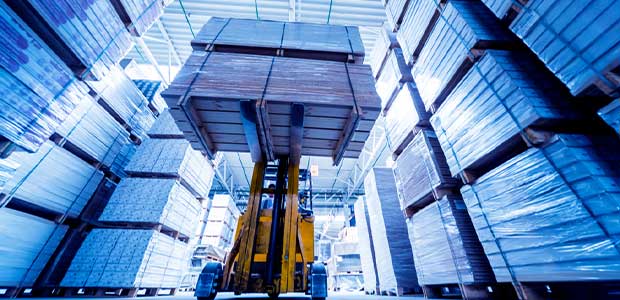
Warehouse Safety: Protecting People, Equipment and Productivity
Safety products can safeguard distribution centers.
- By John P. Clark
- Aug 01, 2022
Warehouse and distribution center efficiency and productivity has risen tremendously in recent decades. However, the gains can be jeopardized by safety breakdowns that lead to personal injury, equipment and product damage. In facilities of any size, this includes costly vehicle impact to pallet racking, which can undermine necessary storage and product throughput.
According to the Bureau of Labor Statistics, each year in the United States, nearly 100 workers are killed and another 20,000 are seriously injured in forklift-related incidents.
Efficiencies have been gained from better floor plans that allow for quicker throughput, from innovative racking solutions, and from robotics and other automation. At the same time, distribution facility employees are more productive than ever. Nevertheless, without the proper industrial safety products and approaches, collisions involving personnel with forklifts, tow tractors and other vehicles can be serious, potentially leading to grievous injury, loss of life and litigation. Vehicle impact with facility equipment, structures and controls can also have severe consequences.
Racking, work platforms like mezzanines and modular offices inside distribution warehouses also need to be protected with barriers to forklift traffic, such as guardrails.
Badly damaged racking (from a vehicle collision) loaded with inventory could potentially collapse without warning if not immediately unloaded, inspected and repaired. A forklift could also go right through the wall of an in-plant modular office inside a distribution warehouse.
Distribution center productivity can also be compromised if important equipment like racking, conveyors, electrical boxes and control panels are not properly protected with barriers from vehicle traffic. In many cases, critical components must be replaced after damage at a substantial cost along with lengthy lead times. With recent parts shortages and logistical delays, replacement could take several months or more, resulting in extended equipment downtime and lower warehouse productivity.
Fortunately, a well-designed and properly installed array of safety products, including guardrails, gates and accessories, can greatly reduce such incidents and protect the facility’s people, equipment and productivity.
In today’s tight labor market, a proactive approach to safety can also pay off in hiring and employee retention. Labor is in high demand now and people want to work in a safe environment. So, a company that shows that it prioritizes keeping its warehouse employees safe with visible barriers like engineered guardrails (to prevent vehicle-pedestrian collisions and rack/equipment damage) has an edge in labor retention.
Optimizing Safety
In warehouses and distribution centers, collisions between forklifts or other vehicles and employees or visitors are a prime concern, so providing adequate protection is essential.
At a minimum, walkways and work areas around racking should be clearly defined. Lines painted on the floor can be helpful in promoting such separation. However, when no physical protection is provided, forklifts and other vehicles can cross over to the pedestrian side for reasons such as operator inattention, distraction or insufficient training.
A more comprehensive solution is to establish visual and physical barriers in the form of guardrails. The guardrails, made with 11-gauge steel, keep pedestrians in defined walkways and vehicles along predetermined routes with protective barriers maintaining separation.
For heavy duty protection, three-ribbed guardrail is designed to withstand impacts from forklifts and other vehicles commonly operated in warehouses and distribution centers. The guardrail can be installed with a single rail or a double rail that offers a 42-inch-high barrier.
A medium-duty guardrail is usually a sufficient and more economical means to separate and protect people in workstations and walkways from light shop traffic. They have two ribs and can be installed at a single or triple rail height.
The guardrails also facilitate efficient traffic flow. When pedestrians are kept out of traffic lanes by guardrails, forklift operators can maintain their expected pace unimpeded, so overall efficiency is improved.
When easy employee access is needed, durable safety gates can be utilized where required. For greater flexibility of use, utilizing safety gates with post openings designed to accommodate an easy change in the swing direction of the gate. For added safety, sturdy steel springs should automatically close the gate after an employee uses it.
Guardrails can also be installed to protect a wide range of important equipment. This includes rack aisle ends, mezzanines/platforms, conveyor systems, machinery, mechanicals, electrical panels, building features and offices situated amid material handling or manufacturing operations. With racking systems and mezzanines protected, inventory stored on the structural equipment is also safeguarded.
Finally, pallet racks can be protected from one of the most likely sources of damage—forklifts—with a highly visible and effective rack protector. The protector’s sections are anchored to the floor, nestling the uprights and standard footplates of the racking. With a low-profile design, this safety equipment is often used at intersections and along high traffic routes to preserve the rack that is most likely to be damaged.
As warehouse and distribution centers become larger and more efficient, it becomes even more important for operation managers to sufficiently protect the safety of their employees and equipment along with the facility’s productivity. Those who proactively implement the proper safeguards, including guardrails and accessories, will profit for years to come in this regard.
This article originally appeared in the July/August 2022 issue of Occupational Health & Safety.